#China Conservation and Research Center for the Giant Panda
Text


(CNN) — Ever since her 2020 birth, Fu Bao has been one of South Korea’s biggest celebrities, with fans eagerly following every milestone of her life at Everland Resort’s Panda World, a theme park in Yongin city.
But the country’s most famous and beloved giant panda is set to bid South Korea a final farewell in April, with preparations now underway for her journey to her new home in China.
During the last week of Fu Bao’s public viewing earlier this month, visitors reportedly endured wait times of 5-6 hours just to catch a glimpse of the celebrity bear for a mere five minutes, as the park restricted viewing times to manage the influx of visitors, according to park officials.
On Fu Bao’s last day of public viewing on March 3, she received farewell gifts, including a panda family doll crafted from bamboo, a bouquet of flowers and heart-shaped pieces of bread from her dedicated keepers at Everland.
Fu Bao fandom

Born to parents Ai Bao and Le Bao in July 2020 as part of China’s “panda diplomacy” program, Fu Bao is South Korea’s first naturally-bred panda.
In the days following her birth, Everland’s social media channels offered fans a steady diet of Fu Bao videos, with its YouTube channel pulling in more than 1.2 million subscribers and, as of February, surpassing 500 million cumulative views, according to the park.
A two-hour video chronicling Fu Bao’s journey from birth to childhood added to the Everland YouTube channel eight months ago has garnered 1.6 million views.
The most recent videos on the channel are now filled with warm and heartfelt messages from viewers, including the beloved cub’s self-proclaimed “online aunties.”
“Fu Bao, you’re a happy treasure that came to us like a miracle during the difficult Covid pandemic,” reads one Youtube comment.
“Your aunties have been so happy to have known you and you made me smile so much. You’re a clever one so I’m so sure you’ll do well in a new environment!”
Another commented that they “can’t believe how time passes so quickly and that we have to let Fu Bao go. I’m so sad to let her go … I support our Fu and love you. Every moment knowing you has been a great joy with laughter. Thank you.”
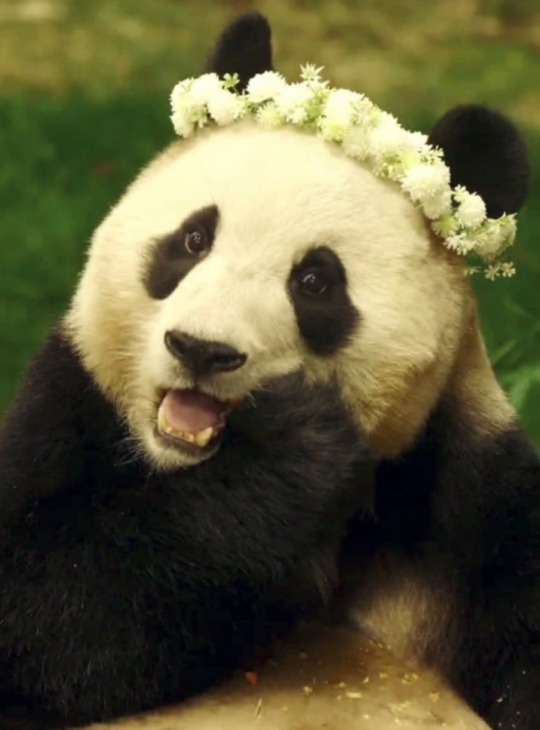
Thanks to Fu Bao’s widespread popularity, her dedicated zookeeper has also found himself in the spotlight, becoming a bit of a social media star himself.
Often referred to as her grandpa, Kang Chul-won offered his own farewell message for Fu Bao, noting that the Korean people’s special love for her all began with social media videos shared during the Covid pandemic when the zoo was closed.
“She brought help and happiness to a society in many ways that was having a difficult time due to the coronavirus,” Kang said in a video posted to YouTube.
During remarks to the press earlier this month, he said people visited the social media sites every day, so it felt like he was “raising her together with them.”
“Of course there are aspects of her cuteness and playfulness, but they cared so much for her and they shared the same emotions of raising a cub together during such difficult times,” Kang said.

Kang Chul-won and Fu Bao
Though one could argue it’s impossible to identify a single social media moment that catapulted Fu Bao to stardom, there are a couple of standout videos that have been particularly popular with viewers.
In one video, Fu Bao clings tightly to Kang’s leg, unwilling to let go, as he spins gently around the room.
After many attempts to uncoil her strong arms, he finally separates himself from her.
The other short video shows Fu Bao clinging to Kang’s arm while relaxing on a wooden bench.
As the zookeeper gently pushes her arm so he can take his phone out of his pocket, the panda links her arms tightly around his left arm.
After he motions to show something on the phone to her, she rolls onto her back.
In an announcement from Everland, the company says Fu Bao will be transferred to the China Conservation and Research Center for the Giant Panda in Sichuan Province in early April.
Everland said that it will keep her in a separate space at Everland Panda World for a month to prepare her to adjust to her new environment before her overseas transfer, which will be carried out in accordance with international regulations.
According to the agreement between Samsung C&T, the parent company of Everland, and the China Wildlife Conservation Association, mature pandas must be returned to China before they turn four years old.
Once Fu Bao departs for China, there will be four giant pandas left at Everland – Fu Bao’s mother Ai Bao, father Le Bao, and their twin babies Rui Bao and Hui Bao, who were born in July 2023.
Source: CNN Travel
youtube
Baby panda 'FuBao' glued to the zookeeper dragging her around | Everland Panda World
16 December 2020
🖤🐼🖤
#Youtube#Fu Bao#panda#Everland Resort#Panda World#Ai Bao#Le Bao#panda diplomacy program#China#South Korea#zookeeper#Kang Chul-won#China Conservation and Research Center for the Giant Panda#Sichuan Province#Samsung C&T#China Wildlife Conservation Association#Rui Bao#Hui Bao#Covid 19#celebrity pandas
4 notes
·
View notes
Photo
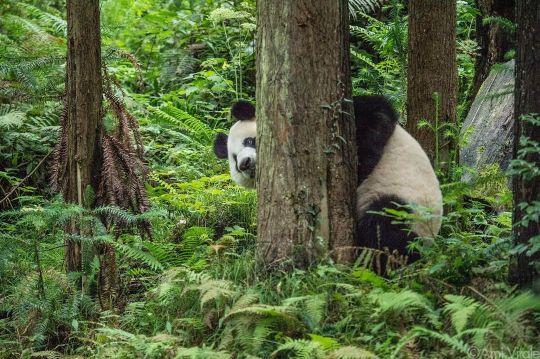
Photo by @amivitale. Peek-a-boo! Twelve year old mother giant panda, Si Xue tries to hide behind a tree at the Wolong China Conservation & Research Center for the Giant Panda in Sichuan Province, China. Because of their low-energy diet, pandas avoid stressful situations and exertion. They are elusive and solitary creatures in the wild. It’s hard to imagine, but these animals were once as mythical and elusive as Bigfoot. They have been around for millions of years, but were only made known to the western world within the last century. The first panda was captured alive only in 1936. By breeding and releasing pandas, augmenting existing populations and protecting habitat, they are on their way to successfully saving their most famous ambassador and in the process putting the wild back into an icon. My book, Panda Love, is sold out but one of my images, Pandas Gone Wild, is currently available in the @vital.impacts Winter Collection. The profits will help support the next generation of environmental storytellers too. Learn about our grants and mentoring programs at vitalimpacts.org (link in profile) All my panda images are available as prints. ⠀⠀⠀⠀⠀⠀⠀⠀ #panda #pandas #babypanda #pandamonium #ipanda #giantpanda #pandacub #endangered #china #conservation https://www.instagram.com/p/CpA2STaOe69/?igshid=NGJjMDIxMWI=
6 notes
·
View notes
Text
9 Beautiful Temples in China You Cannot Miss.

Some of the most exquisite temples in the world may be found in China, a country known for its lively culture and extensive history. These temples, which range from opulent old imperial palaces to tranquil mountain retreats, provide a window into China's architectural treasures and spiritual practices. We'll cover a list of nine temples in this introduction that you should not miss when visiting China. With their elaborate decorations, spiritual atmosphere, and creative designs, these temples draw tourists from all over the world. Each one of them has its own distinct beauty and importance. These temples provide an amazing trip through China's cultural past, whether you're taking in the majesty of Beijing's Forbidden City or the calm beauty of Sichuan's Leshan Giant Buddha.
These temples are dispersed throughout the wide length of China, from the busy metropolises of Beijing and Shanghai to the serene landscapes of rural provinces, encouraging visitors to experience the nation's different regions and immerse themselves in its rich spirituality and history. Take a virtual tour with us to see some of the most stunning temples in China and learn about the cultural importance and ageless beauty of these hallowed locations. These temples will leave you in awe of the grandeur of China's ancient past, whether you're a history buff, a spiritual seeker, or just an art and architectural lover.
Here are some beautiful temples in China you cannot miss.
1. Beijing, the Forbidden City: Located in the center of Beijing, the Forbidden City, sometimes referred to as the Palace Museum, is a famous representation of Chinese royal architecture. The imperial palace of the Ming and Qing dynasties, this UNESCO World Heritage Site is well-known for its imposing halls, elaborate pavilions, and lovely gardens.
2. China's Great Wall: One of the most stunning architectural wonders in the world, the Great Wall of China, is a must-see location for visitors visiting China. The Great Wall, which stretches more than 13,000 miles across northern China, offers visitors stunning views of the surroundings and an understanding of the country's rich cultural heritage.
3. Xi'an's Terracotta Army: Emperor Qin Shi Huang was buried with thousands of life-size clay warriors, horses, and chariots, known as the Terracotta Army, to guard him in the afterlife. This archaeological monument, which was found in the vicinity of Xi'an in 1974, is a UNESCO World Heritage monument and provides an intriguing look into the military might and artistry of ancient China.
4. Huangshan, or the Yellow Mountains: The Huangshan, also known as the Yellow Mountains, is a UNESCO World Heritage Site renowned for its eerie clouds, twisted pine trees, and striking granite peaks. The Yellow Mountains, which are in the Anhui province of eastern China, have long served as an inspiration to Chinese poets and painters. They are particularly beautiful at dawn and dusk.
5. Guilin's Li River: The Li River is a charming river in southern China that is well-known for its traditional towns, bamboo gardens, and karst limestone peaks. Travelers may take in the breathtaking panorama captured in innumerable Chinese art and photos by taking a sail down the Li River.
6. Lhasa, Tibet's Potala Palace: The Potala Palace is a stunning fortress-style building that was formerly the Dalai Lama's winter retreat. One of the holiest places in Tibetan Buddhism, the Potala Palace, is situated in the center of Lhasa, the capital of Tibet.
7. The Giant Panda Breeding Research Base in Chengdu, China: The conservation institution Chengdu Research Base of Giant Panda Breeding is devoted to the breeding and preservation of giant pandas. This facility, which is situated in Chengdu, Sichuan Province, enables tourists to see these cute animals in their natural environment and discover the conservation initiatives being taken to save them.
8. Dunhuang's Mogao Caves: In Dunhuang, Gansu province, the Mogao Caves, also called the Thousand Buddha Grottoes, are a UNESCO World Heritage Site close to the old Silk Road. These caverns are among the most significant cultural monuments in China since they are home to an amazing collection of Buddhist paintings and artwork that dates back more than a millennium.
9. Giant Buddha of Leshan (Leshan): The Leshan Giant Buddha is a gigantic stone statue of the Buddha that is located close to Leshan, Sichuan Province, and is carved into a cliff overlooking the confluence of three rivers. The world's tallest stone Buddha statue, standing over 230 feet tall, is a monument to the dedication and skill of ancient Chinese artisans and is recognized as a UNESCO World Heritage Site.
Conclusion
The beautiful temples of China offer a captivating journey through the country's rich history, culture, and spirituality. From the iconic Forbidden City in Beijing to the serene Leshan Giant Buddha in Sichuan, these temples showcase China's architectural marvels and spiritual traditions. For travelers seeking to explore these magnificent temples, obtaining a China visa from Delhi is the first step towards embarking on an unforgettable journey. With the visa in hand, travelers can immerse themselves in the beauty and tranquillity of these sacred sites, experiencing the timeless allure of China's ancient past. Whether you're admiring the intricate carvings of the Mogao Caves in Dunhuang or marveling at the majestic peaks of the Yellow Mountains in Anhui, each temple offers a unique glimpse into China's cultural heritage and natural beauty. So, whether you're a history buff, a spiritual seeker, or simply an avid traveler, don't miss the opportunity to explore the beautiful temples of China. With their awe-inspiring architecture, breathtaking scenery, and profound spiritual significance, these temples promise an enriching and unforgettable experience for all who visit.
#China Visa from Delhi#China Visit Visa from Delhi#China Tourist Visa from Delhi#China visit visa processing time from Delhi#China Tourist visa cost from Delhi#China Tourist visa price from Delhi#China Visa appointment in Delhi
0 notes
Text




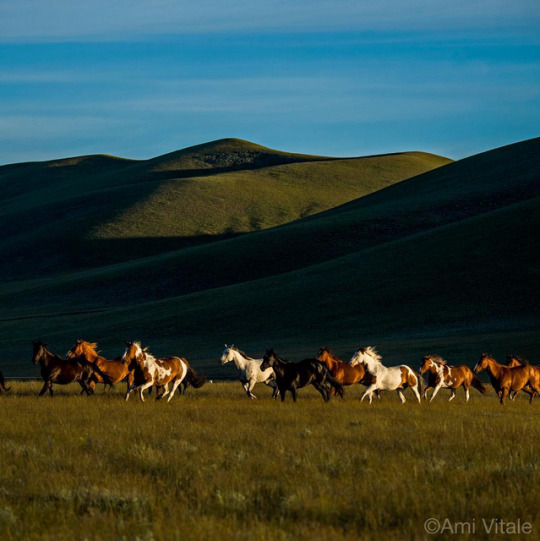






Photos and text: @amivitale
1-. One-year-old Jin Bao Bao has gotten the hang of climbing trees at Bifengxia Giant Panda Breeding and Research Center in Sichuan Province, China
2-. An elephan waves his trunk up in the air to smell as it browses at the Lewa Wildlife Conservancy in Northern Kenya
3-. An elephant observes me as i photograph him at @loisaba_conservancy in Laikipia, northern Kenya
4-. Back home in Montana and thrilled to be teaching at one of my favorite places in the world
5-. Horses on an early morning at the inspiring J-L Ranch in Centennial Valley in Montana
6-. Tawny eagles fly high above the skies at the Lewa Wildlife Conservatory
7-. A goat welcome from Namunyak Wildlife Conservancy, near Sarara Camp
8-. A priest stands in front of a destroyed church in Sri Lanka's Northern province of Jaffna - Ami Vitale
9-. a spotted deer, also known as a chital, in the mist of Chitwan National Forest, Nepal. by ami vitale
10-. All journeys have secret destinations of which the traveler is unaware. Martin Buber - At J-L Ranch in Montana's Centennial Valley
11-. A jackal at night on the Namunyak Wildlife Conservancy in Kenya
0 notes
Text

Crafted by nature.
Sichuan, China. A giant panda rests at the China Conservation and Research Center for the Giant Panda in Wenchuan county, Aba prefecture.
Photograph: Shutterstock /Guardian #giantpanda #sichuan #china #conservation
1 note
·
View note
Text
An Insider guide on the best places in China for a panda tour

Are you planning to explore the Sichuan Panda Tour in China? Check out the must-visit spots when here to experience the best time.
China is one of the bucket list locations for most travelers to explore its natural beauty. It combines everything nicely, from the wide variety of scenic extravaganzas to the culture. But besides being the hub spot of natural beauty, China is also the ultimate destination for exploring Pandas. This is because the population of giant pandas has been decreasing over the years steadily. Keeping that in mind, China has taken proper measures to care for pandas by building breeding bases. But, when here, choosing the perfect location to explore Sichuan Panda Tour can be a bit overwhelming. So, to help you out better, here we have listed the top locations of all time.
Chengdu panda base
This base is located at a distance of about 16 kilometers from the suburban location of Chengdu. It is only located at a distance of 30 minutes and is just an open park with several pandas. This is also a must-visit place to help you to feast your eyes by exploring the panda bases. One of the best times to visit here is from March to May. During this time, pandas are extremely active and play around to give you the ultimate experience of a lifetime. When you are here, you can also check out the giant panda museum to understand better about pandas. In addition, you can also wander leisurely to your heart's content through the lush green vegetation.
Dujiangyan panda base
This is the research and conservation center for giant pandas. It is located about 62 kilometers from the Chengdu downtown area with a maximum travel time of 1-1.5 hours. Dujiangyan is one of the closest bases to Chengdu to experience panda habitats and volunteer programs. When here, tourists can experience an educational and relaxing time with pandas. Dujiangyan is surrounded by verdant bamboo forests and completely green mountains.
Bifengxia panda base
Bifengxia is a research and conservation center that is about 155 kilometers from the downtown area. It takes an overall time limit of 3 hours to drive here from Chengdu. The exact place where Bifengxia is located is also popularly known as the lung of Sichuan. It is located at an altitude of 1000 meters in height. This base is the perfect combination of animals and nature at large. This base comprises more than 40 pandas, including babies as well. After exploring pandas and their habitat here, you can also explore the Animal park consisting of more than 400 species.
Wolong base
This is one of the largest breeding centers for pandas worldwide. The distance between Wolong and Chengdu is about 100 kilometers, with a two-hour transfer time. Wolong is located at a standing place of more than 1700 meters above the actual sea level with a total area of 150 hectares. This place offers one of the most dynamic, harmonious, and self-sustaining bases around the globe. Tourists can also experience the one-day volunteering program here to learn about pandas.
So, make most of your time exploring Chengdu Panda Volunteer by visiting these spots when in China. When booking your reservations, check out Absolute Panda for amazing deals of all time!
0 notes
Photo

Play time
A giant panda cub plays at Shenshuping Panda Base of China Conservation and Research Center on Feb. 3 in the Sichuan Province of China.
gettyimages.com
#gettyimages.com#photographer#giant panda cub#panda#shenshuping panda base of china conservation and research center#sichuan province#china#nature
17 notes
·
View notes
Video
DSC05156 by Nickis Jerry
Via Flickr:
#中國大熊貓保護研究中心都江堰基地#China Conservation and Research Center for the Giant Panda#pandas#giant pandas#animals#cute
53 notes
·
View notes
Photo

Researchers dressed in panda costumes check the body temperature of a panda cub during its physical examination at the Hetaoping Research and Conservation Center on December 3, 2010.
© Reuters.
177 notes
·
View notes
Photo
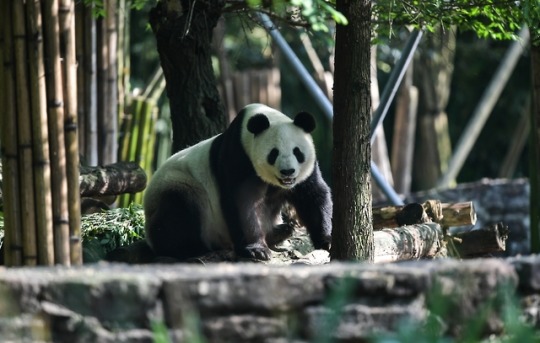
Giant panda Bai Yun at the Qingchengshan Base of the China Conservation and Research Center for Giant Pandas in Dujiangyan, southwest China's Sichuan Province
0 notes
Photo
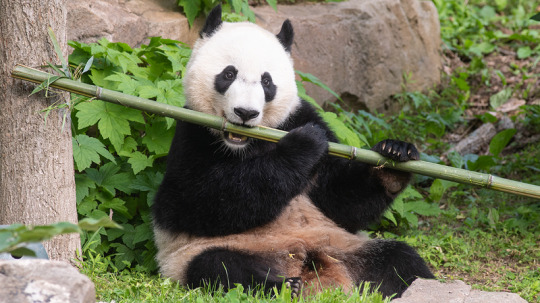
The Smithsonian's National Zoo is bidding farewell this week to one of its most popular bamboo-loving residents: Bei Bei.
Why? The black-and-white bear is on temporary loan to the National Zoo from the Chinese government. That's the case with the majority of captive pandas around the world. Bei Bei's loan agreement stipulated that he must go to China when he reached 4 years of age.
Bei Bei will be sent to China on Tuesday to live at the Bifengxia Panda Base, run by the China Conservation and Research Center for the Giant Panda. Once he reaches sexual maturity, he'll enter its breeding program with the ultimate goal of expanding the captive panda population.
Bei Bei's siblings, Bao Bao and Tian Shan, were sent to China in 2016 and 2010, respectively. With Bei Bei's departure, the Smithsonian's National Zoo will be without an adolescent panda.
Bei Bei, which means "precious, treasure" in Mandarin Chinese, was born at the zoo on Aug. 22, 2015. He came into the world pink, hairless and blind, approximately the size of a stick of butter. Now he weighs 240 pounds.
With 65 Pounds Of Bamboo, Giant Panda 'Bei Bei' Prepares For Flight To China
Photo: Skip Brown/Smithsonian's National Zoo
273 notes
·
View notes
Photo

Photo by @amivitale. A baby giant panda tests out its newly acquired walking skills at Bifengxia Panda Base, managed by the China Conservation and Research Center for the Giant Panda. It takes baby pandas about three months to grow strong enough to take a few steps. By breeding and releasing pandas, augmenting existing populations and protecting habitat, they are on their way to successfully saving their most famous ambassador and in the process putting the wild back into an icon. My book, Panda Love, is sold out but one of my images, Pandas Gone Wild, is currently available in the @vital.impacts Winter Collection. The profits will help support the next generation of environmental storytellers too. Learn about our grants and mentoring programs at vitalimpacts.org (link in profile) ⠀⠀⠀⠀⠀⠀⠀⠀ #panda #pandas #babypanda #pandamonium #ipanda #giantpanda #pandacub #endangered #china #conservation https://www.instagram.com/p/Co4y_wcuv1M/?igshid=NGJjMDIxMWI=
3 notes
·
View notes
Text
This Video of Baby Pandas Will Make Your Day
There’s nothing like a cute baby panda to warm your heart on a chilly Monday morning. The China Conservation and Research Center for the Giant Panda released footage of the furry friends at bedtime and it will literally make you smile so hard.
The baby pandas are seen crawling out of plastic tubs, used to keep the pandas separated as they wait for their keepers. It seems that the baby pandas…
View On WordPress
0 notes
Photo

老Yang教员组今天为大家整理一篇优秀的essay代写范文 -- Are pandas endangered?,文章讲述熊猫是什么?根据维基百科,大熊猫被称为大熊或大熊猫,以区别于无关的小熊猫。它是一头产于中国中南部的熊,穿着黑白皮毛。他们大多生活在中国中部的一些山脉中。众所周知,中国四川省是熊猫的故乡。熊猫主要吃竹子,但有时也吃其他草,野菜甚至肉。同时有需要essay润色查重、辅导代写、托福GRE考试保分、网课全方位包课的家人们可以联系老Yang微信(Wechat ID: ymf2531)进行咨询喔~
Are pandas endangered?
What is the panda? According to Wikipedia, The panda is known as panda bear or the giant panda to distinguish it from the unrelated red panda. It is a bear native to south central China which wears black and white fur. They mostly live in a few mountain ranges in central China. As is known to all, Sichuan Province in China is the famous hometown to the panda. The panda mainly eats bamboo but sometimes eat other grasses, wild tubers or even meat. With the deterioration of the living shelters and the killing of human beings, the number of the panda decreases rapidly. Now it is a conservation reliant endangered species. Now, we can hardly see wild pandas in the mountains. The majority of the pandas is in the protective zones with typical measures and treatment.
Why is the number of the panda so small? It is a common sense that the panda evolves from the ancient creatures. So from their living styles and habitus, we can learn a lot about the creatures’ evolvement. As an animal, the panda has been recognized as living fossil of the creatures. But it is a pity to see that the number of the panda is decreasing rapidly. From some researches, we may find some main factors which contribute to the rapid decrease in the number of the panda. (McKinney, Michael L, 498-512) Firstly, the abuse and killing of the panda is the main reason. The human beings hunt for the pandas with the purpose of getting their fur just like hunting for sharks for their fins. From some researches, the numbers of the panda was decreasing by 60% due to human beings’ killing until 1960s. When the government has noticed the rapid change in the number of the panda, some measures have been taken to protect the endangered animals. Besides this, the second reason is the lower potentia generandi of the panda. (Loucks, Colby J, 558-559) Nowadays, we may hardly see the wild panda with the majority of it in the protective zones. Why? I think the lower potentia generandi is the key point to the small scale of the panda. It is harder for the panda to give birth to new lives by the female panda. So what we often see on TV or online appears in the research center of the panda. What’s more, I think, the change of the environment of the living shelter of the panda makes the panda become much harder to live by themselves in the wild places. With the development of the economy, the human beings pay more attention to the economic interest rather than the environment. More pollution is discharged into nature which leads to the death of many biological creatures. Not only the plants are facing the death caused by the pollution, but also many animals included the panda are suffering from it. Based on these reasons, the number of the panda is so small, thus it is on the verge of extinction.
After we talk about the reasons which cause the rapid decrease in the number of the panda, we continue to explore the reason why the giant panda only appears in China. It may confuse many readers that why the giant panda cannot appear in other countries. It is an interesting question. Schaller and George B in their research, point out that the feeding ecology of giant pandas makes the panda easier to live in China. The panda as an evolutionary animal once lived in many places in the world. Due to the change with respect to the climate and the crust of the earth, many creatures were extinct. At the same time, the panda becomes more used to the bamboo especially to the fargesia. As is known to all, to some degree, the bamboo is the particular plant in China. We may hardly see it in other countries. If we can, we cannot see large scale of the bamboo just like in China. So I think the feeding ecology contributes to the appearance of the panda in China. On top of it, the mild climate in China is another factor. The climate in the mountain especially in Sichuan Province of China provides a good natural condition for the panda to reproduce their generation. So we may see them more in China.
In the text above, I have pointed out that the panda become used to the bamboo. But it is contradictory to find that the panda belongs to carnivorous animals. Is it what causes the change in eating? Some researchers pointed out that natural selection decides the evolutionary of the panda in appetite. (Jin, Ke, 2) The panda used to eat meat all the times, but with the change of the living shelter, it’s hard for the panda to hunt for more food consist of meat. So the panda was compelled to eat what appears around them. At that time in China, the bamboo was easier to find in the shelter of the panda. Without other food, the panda became used to eat bamboo. But it cannot declare that the panda never eat other food. As is known to all, the panda also eats wild tubers. So if you see the panda eats some animals or some plants, it may be accepted by you.
Besides the topic we have talked about above, the important thing we need to pay more attention to is the protection of the panda. The giant panda is an endangered species, threatened by continued habitat loss and by a very low birthrate, both in the wild and in captivity. Its range is currently confined to a small portion on the western edge of its historical range. So it is urgent for us to take some steps to protect them. China as the hometown to the panda, has published many laws to protect the panda. Anyone who hunts for the panda or hurts the panda will be punished severely. What’s more, some famous protective zones for the panda are established including Wolong National Nature Reserve. The Wolong National Nature Reserve was set up by the PRC government in 1958 to save the declining panda population. We may often see some new birth in the reserve. Moreover, the government throws many funds and researches into the protection of the panda including the research on the birth of the panda. To overcome the low birth of the panda, the relevant scientists devote many efforts to do research on it. And finally they get some remarkable breakthrough in this question. So we often see some panda parents with their babies appear online. What’s more, in order to deal with the pollution and destruction of the natural habitat of the panda, in the 1990s, however, several laws (including gun control and the removal of resident humans from the reserves) helped their chances of survival. The number of wild pandas has started to increase in some areas with these renewed efforts and improved conservation methods, though they still are classified as a rare species. The giant panda is among the world's most adored and protected rare animals, and is one of the few in the world whose natural inhabitant status was able to gain a UNESCO World Heritage Site designation. The Sichuan Giant Panda Sanctuaries, located in the southwest Sichuan province and covering seven natural reserves, were inscribed onto the World Heritage List in 2006. In 2012, Earthwatch Institute, a global nonprofit that teams volunteers with scientists to conduct important environmental research, launched a program called "On the Trail of Giant Panda". This program, based in the Wolong National Nature Reserve, allows volunteers to work up close with pandas cared for in captivity, and help them adapt to life in the wild, so that they may breed, and live longer and healthier lives. At the same time, we may often see that some pandas from China are sent abroad. They are seen as the bridge connecting China with the other. The reason why the government of China does it is to get more attention from the world with the purpose of protecting the panda. If more people like this rare animal, they may give more attention to the development of the scale of the panda. Meanwhile, more support will be given to the protection of the panda. I think it is a good thing. But we may feel it pity and painful to find that some pandas sent abroad are dead due to illness. We want more attention and more care to be given to the panda. They are our friend. Without them, we may lose much happiness during our life.
The panda is not only an animal, but also our friend. We may have no chance to participate in the research on the panda. We may also have no much time to devote ourselves into the protection of the panda. But we can give our some care to the development of the protection of the panda. We can struggle with the criminal events which give threaten to the protection of the panda. We can cooperate with each other to give some advice on the protection of the panda.
We feel so painful to hear that the panda is on the verge of extinction. We often see ourselves as children with our babies to take photos with the panda in some safe distance with the consideration of the safety of the panda. Our babies often feel happy and excited to see their friends. We don’t want lose this peaceful and nice scene. We are the leader of the world, but we are not the sole creature of the world. What we need to do is to get along well with them. We can breathe the fresh air with the panda with the efforts to protect the shelter environment. We can share our happiness with the panda by watching them play. The protection laws are always a restraint to the public. It is our duty but also the responsibility to protect them. Protecting the panda is to protect our interest in the balanced nature.
Cited Works
McKinney, Michael L. "Extinction vulnerability and selectivity: combining ecological and paleontological views." Annual Review of Ecology and Systematics (1997): 495-516.
Loucks, Colby J., et al. "The giant pandas of the Qinling Mountains, China: a case study in designing conservation landscapes for elevational migrants." Conservation Biology 17.2 (2003): 558-565.
Schaller, George B., et al. "The feeding ecology of giant pandas and Asiatic black bears in the Tangjiahe Reserve, China." Carnivore behavior, ecology, and evolution. Springer US, 1989. 212-241.
Jin, Ke, et al. "Why does the giant panda eat bamboo? A comparative analysis of appetite-reward-related genes among mammals." PloS one 6.7 (2011): e22602.
老Yang留学教育原创版权郑重声明:原创优秀范文源自编辑创作,未经官方许可,网站谢绝转载。对于侵权行为,未经同意的情况下,老Yang有权追究法律责任。我们主要业务有essay代写、assignment代写、paper代写、作业代写、论文代写、雅思考试、托福考试、GRE考试、网课包课等。
老 Yang 为留学生提供靠谱隐私的留学学业服务,亲们可以进入主页了解和获取更多优秀范文,有需要可以咨询老Yang微信(WeChat ID: ymf2531)。
0 notes
Link

Cao Cao, a key participant in China's efforts to save giant pandas, sits is in labor. In July, she delivered the first twin cubs born to a wild male and a female raised in captivity. (China Conservation and Research Center for the Giant Panda)
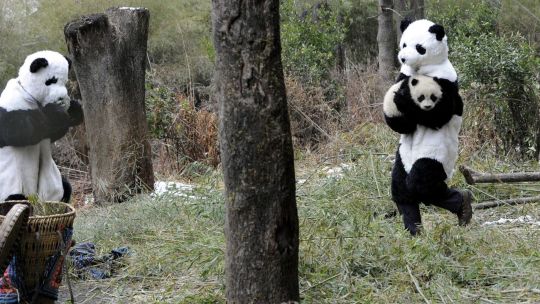
A Chinese researcher dressed in panda costume holds a panda cub before transferring it to a new living environment at the Hetaoping giant panda wild training center in Wolong National Nature Reserve, in southwestern China's Sichuan province. (Wang Xiwei / Imaginechina)
Excerpt from this LA Times article:
Wild pandas, once found in 17 provinces, now survive in just three. Their habitat is fragmented, with 73% in groups so small there is a strong chance they will not survive, according to a 2017 report from Beijing Forestry University.
Back in the 1970s, the overall panda population dipped to about 1,000. In response, the Chinese government spent tens of millions of dollars to establish training centers, and forest reserves, helping the numbers recover to roughly 2,200. Of those, roughly 25% reside in the scientific centers, zoos or other such facilities.
The roly-poly celebrities are replete with political and cultural significance, and economic value as a tourism drawing card. So to ensure their long-term survival, China has initiated a make-or-break experiment sending captive pandas into the wild permanently to boost fragile populations scattered in six isolated mountainous regions.
Equally vital is a plan for a 5-million-acre conservation park — twice the size of Yellowstone National Park — that is to include 67 current reserves and be financed by the Bank of China at a cost of $1.1 billion. Researchers hope the park, due for completion by 2023, will ensure the successful release of dozens of captive-bred pandas to reestablish wild populations in areas that have not seen them for decades.
The Hetaoping base, where Cao Cao usually resides, has released four captive-bred females since 2016 in hopes they would mate with wild males. Cao Cao is the only one with a confirmed pregnancy.
At Hetaoping, cubs are prepared for release largely without human contact. They are raised by their mothers in large bushy enclosures until independent, then moved together to larger isolated compounds. Their only interaction with humans is with the keepers who deliver bamboo daily, dressed in panda suits liberally soaked in panda urine to cover the human smell. Anyone visiting the center must don the urine-soaked suits. Training to survive in the wild is left to the mothers.
1 note
·
View note
Photo

A giant panda plays after snow at Shenshuping base of China Conservation and Research Center for the Giant Panda in Wolong National Nature Reserve, southwest China’s Sichuan Province, on Dec. 17, 2020.
Photographer: XINHUA NEWS AGENCY VIA GETTY IMAGES
#xinhua news agency#photographer#getty images#giant panda#panda#shenshuping bse#china conversation and research center for the giant panda#wolong national nature reserve#sichuan province#china#nature
29 notes
·
View notes